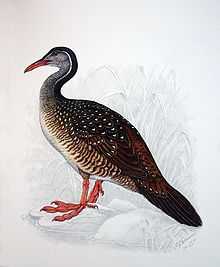African finfoot
| African finfoot | |
|---|---|
 | |
| Conservation status | |
| Scientific classification | |
| Kingdom: | Animalia |
| Phylum: | Chordata |
| Class: | Aves |
| Order: | Gruiformes |
| Family: | Heliornithidae |
| Genus: | Podica Lesson, 1831 |
| Species: | P. senegalensis |
| Binomial name | |
| Podica senegalensis (Vieillot, 1817) | |
The African finfoot (Podica senegalensis) is an aquatic bird inhabiting the rivers and lakes of western, central, and southern Africa.
Description
The African finfoot is an underwater specialist with a long neck, a striking sharp beak, and bright red, lobed feet. The plumage varies by race, generally pale underneath and darker on top. The males are usually darker than the females. It superficially resembles South America's torrent duck.
Habits and Range


The African finfoot can be found in a range of habitats across Africa, where there are rivers, streams and lakes with good cover on the banks. This range includes forest, wooded savannah, flooded forest, and even mangrove swamps.
The finfoot feeds on aquatic invertebrates, including both adults and larval mayflies, dragonflies, crustaceans, also snails, fish and amphibians. They are thought to be highly opportunistic and take some of their prey directly off the waters surface. They are adept out of water and will forage on the banks as well, unlike the grebes, which they resemble but are not related to.
Finfoots are usually seen singly or in pairs. They are very secretive. Even experienced ornithologists see them very rarely, making them a prized sighting for birders and twitchers. Because they are so elusive, it is not known if they spend most of their time in the water, where they are almost always seen, or on land.
Their time of breeding varies by area, usually coinciding with the rainy season. They build a nest, nothing more than a mess of twigs and reeds, on a fallen tree above the water. Two eggs are laid and incubated solely by the female. The chicks leave the nest a few days after hatching.
Relationships
The African finfoot belongs to a family whose only other members are the masked finfoot and the sungrebe. Their relationships to other birds are poorly understood.
Status and Conservation
The African finfoot's conservation status is hard to determine, given its elusive nature. It is not considered threatened, as it is not persecuted or targeted by hunters, and while scarce, it is very widespread. However, there is concern that it may become threatened, as wetlands are cleared and watercourses altered and polluted. It is also thought to tolerate only minimal disturbance. This and increased habitat fragmentation mean that the species needs to be monitored to safeguard it. There are currently no African finfoots in captivity.
References
- ↑ BirdLife International (2012). "Podica senegalensis". IUCN Red List of Threatened Species. Version 2013.2. International Union for Conservation of Nature. Retrieved 26 November 2013.
- Handbook of the Birds of the World, Volume Three, Hoatzin to Auks; de Hoyo, Elliot and Sargatal, ISBN 84-87334-20-2
| Wikimedia Commons has media related to Podica senegalensis. |
External links
- African finfoot - Species text in The Atlas of Southern African Birds.
